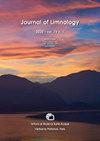Periphyton growth on allochthonous input in streams may lead to higher individual growth rates of the invasive New Zealand mud snail (Potamopyrgus antipodarum)
IF 1.1
4区 环境科学与生态学
Q4 LIMNOLOGY
引用次数: 0
Abstract
The aquatic, invasive New Zealand mud snail (Potamopyrgus antipodarum) exploits a variety of food sources. Here we examine the change in growth of snails that fed on periphyton colonizing leaf litter, wood, rock, and a control. Juveniles were grown in the lab on Spirulina algae powder (control) or periphyton grown on rock, leaf litter, or wood. Length was measured at the beginning of the experiment and after eight weeks. Snails grown on leaf litter increased in length more than twice as much as the control and the snails in the rock treatment, and the snails grown on wood showed an increase in length more than twice as much as snails in the rock treatment. This suggests that allochthonous material may contribute to a more nutritious food source for New Zealand mud snails and possibly aid in their invasion success.溪流中外来输入的周围植物生长可能导致入侵新西兰泥螺(Potamopyrgus antipodarum)的个体生长速率更高。
水生入侵的新西兰泥蜗牛(Potamopyrgus antipodarum)利用各种食物来源。在这里,我们研究了以周围植物为食的蜗牛在凋落叶、木材、岩石和对照中的生长变化。幼体在实验室中生长在螺旋藻粉(对照)或生长在岩石、凋落叶或木材上的周围植物上。在实验开始和8周后分别测量长度。在凋落叶上生长的蜗牛长度比对照和岩石处理的蜗牛长两倍以上,在木头上生长的蜗牛长度比岩石处理的蜗牛长两倍以上。这表明外来物质可能为新西兰泥螺提供更有营养的食物来源,并可能有助于它们的入侵成功。
本文章由计算机程序翻译,如有差异,请以英文原文为准。
求助全文
约1分钟内获得全文
求助全文
来源期刊

Journal of Limnology
地学-湖沼学
CiteScore
2.70
自引率
6.20%
发文量
12
审稿时长
3 months
期刊介绍:
The Journal of Limnology publishes peer-reviewed original papers, review papers and notes about all aspects of limnology. The scope of the Journal of Limnology comprises the ecology, biology, microbiology, physics, and chemistry of freshwaters, including the impact of human activities, management and conservation. Coverage includes molecular-, organism-, community-, and ecosystem-level studies on both applied and theoretical issues. Proceedings of workshops, specialized symposia, conferences, may also be accepted for publication.
 求助内容:
求助内容: 应助结果提醒方式:
应助结果提醒方式:


